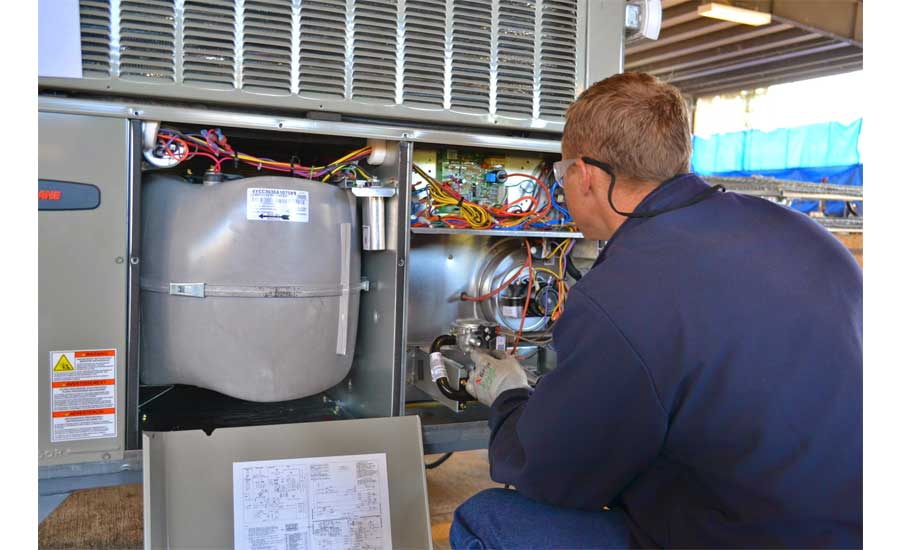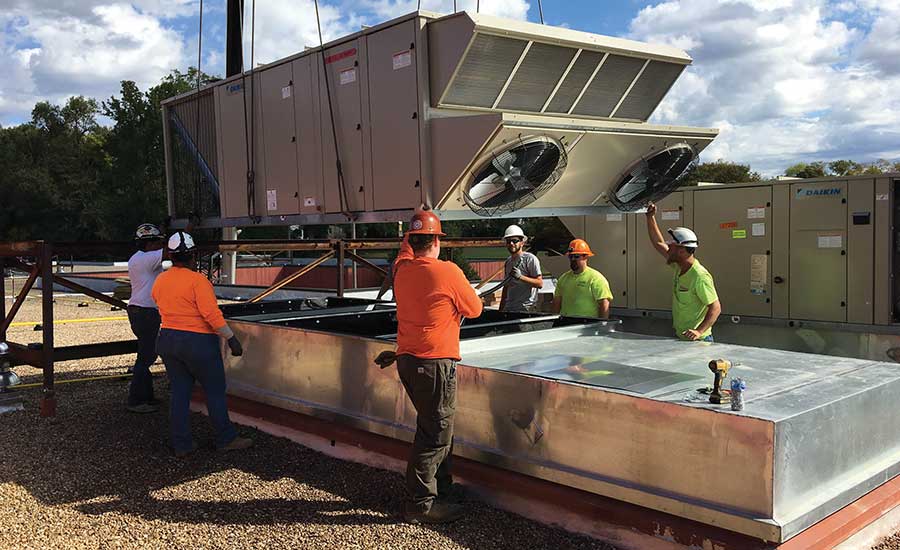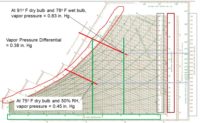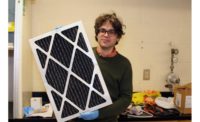Theoretically, these infected droplets could be dispersed through an HVAC system and spread to other occupants, but this scenario appears to be unlikely. Still, it could be possible under certain circumstances, which is why The ACHR NEWS asked the following industry experts to discuss what measures should be taken with HVAC systems to reduce the risk of exposure to the virus in both residential and commercial applications:
- William Bahnfleth, ASHRAE presidential member and professor of architectural engineering at Pennsylvania State University;
- Rob Tanner, director of marketing of air handling systems at Johnson Controls;
- Jim Bogart, senior product manager of air handling systems at Johnson Controls; and
- Donny Simmons, president of commercial HVAC Americas at Trane Technologies.
ACHR NEWS: Can residential and commercial HVAC systems spread the COVID-19 virus?
Bahnfleth: There have been thousands of papers and articles published since the pandemic started, and in all of the reports of how COVID-19 is transmitted, there are no reports of space-to-space transmission through an HVAC system. In other words, there are no documented cases of the disease being caused by infectious aerosol being picked at a return, going through the air handling unit and the filters, and infecting someone far away. From what we know so far, there is little reason to view an air handling unit as a hotspot of infection risk.
However, HVAC systems do move air around in spaces, because that's the only way to condition air. That has the potential to spread contaminants, but most HVAC systems — with the exception of residential split systems — provide ventilation and filtration, which are both risk-reducing factors.
Bogart: As far as COVID-19 is concerned, it's important to understand that there aren’t many laboratory studies on it, because the government's not letting that virus out for testing. So, people are making estimates with what they know from other viruses, which means that yes, it could be spread through the HVAC system, but every system is different. To what degree the virus is infectious and whether it can be spread through a system really depends on the system itself. And since they're all unique, it's difficult to say that one system is going to be worse than another system.
Simmons: The CDC has indicated that the primary mechanism for transmission of the virus is through person-to-person spread. This means that maintaining social distancing (about 6 feet) is one of the best strategies for preventing the spread of COVID-19. With that said, it is important for building owners and occupants to realize that they can work to minimize microbiological spread through dilution, exhaust, and cleaning of the air.
ACHR NEWS: Have there been any documented cases of the COVID-19 virus spreading through an HVAC system and infecting individuals?
Bahnfleth: There is one widely discussed example of a restaurant in Guangzhou, China, where an incomplete analysis by researchers accepted the assertion that transmission of COVID-19 is by large droplets over short distances and concluded that the infection of diners not in close contact with the index patient must mean that "strong airflow" from fan coil units pushed large droplets beyond the 1- to 2-meter radius associated with short-range transmission. It ignored the fact that when an infected person breathes, talks, or coughs, they create a spectrum of virus-laden droplet sizes, some of which will evaporate to droplet residues that can remain airborne for extended periods.
A second study examined the incident in much more detail and reached a different conclusion. Those investigators found that the fan coil units were just recirculating air inside of the restaurant; there was no outside air supply and no exhaust fans running at the time of the incident. They measured the ventilation rate in that restaurant and found it to be as little as one-tenth of what it would be if the restaurant were ventilated per ASHRAE’s Standard 62.1, Ventilation and Acceptable Indoor Air Quality. The low ventilation rate meant that the contaminated air the infected person was producing was going to concentrate in the space.
In that restaurant, people became sick at only three tables out of 18 — the table where the infected person was sitting, and one on either side. That was probably because they were close to that person in the area where infectious aerosol concentration was high. Nobody else was infected — not even the servers who came to the table. So, it appears to be a combination of the concentration in the air and how long people were exposed to it that determined whether they were infected. There are many poorly ventilated spaces in buildings, so there could be more airborne transmission occurring than some think.
ACHR NEWS: How can HVAC systems be modified in order to potentially reduce the spread of COVID-19?
Simmons: There is strong evidence from ASHRAE and other sources that HVAC technologies can mitigate the risk of exposure to infectious aerosols in built environments; however, the role of building systems in the transmission and mitigation of COVID-19 in buildings is yet to be fully tested and confirmed. What we do know is that proper design, installation, and maintenance of HVAC systems are key to maintaining healthier indoor air quality and more efficient built environments.
In preparation of building re-occupancy, building owners can proactively assess their current HVAC system ventilation, exhaust, maintenance schedules, and the control sequences according to ASHRAE’s COVID-19 building readiness/reopening guidance. When it is deemed appropriate, building owners can reach out to HVAC service providers to assess current system readiness. Depending on the type of systems and ventilation requirement, the tasks may include revising control sequences, changing into better filtration media, retrofitting equipment to handle larger ventilation loads, and many others.
Tanner: If we’re looking at ways to reduce the spread, it really comes down to trapping, diluting, and/or inactivating the virus. Ventilation will help with dilution, and on the commercial side, ASHRAE has addressed this topic pretty well on its website. The key is to flush the building with outside air at rates that would not be sustainable for comfort control. This is particularly the case if buildings have been vacant for a while. There are even discussions about the need for periodic flushing when occupants leave the space, which would be a new ventilation strategy.
Better filtration can involve upgrading filters to a higher MERV rating, but of course, that comes with increased pressure drop, which needs to be considered. For inactivating the virus, there are two technologies that have proven to work well with pathogens. The first is UVC light, which is known for surface decontamination or coil cleaning, but at a much higher intensity, it actually inactivates the virus as it moves through that section of the system. The other technology is bipolar ionization, which generates positive and negative ions that flood through the system and even into the spaces they serve to inactivate viruses.
I think the general guidance is, increase ventilation as much as you can reasonably; try to improve your filtration to the level that you can; and then use active air cleaning technologies to the point that won’t involve having to do radical changes to the system or use significantly more energy.
Bahnfleth: As far as ventilation is concerned, we don't know enough about the COVID-19 virus to say that so many cfm per person are protective, but we expect that more ventilation would reduce the risk of airborne infection. It's been suggested to increase the outside air, but exactly how much is hard to say. It's been an abundance of caution approach at this point; if you're able to increase ventilation, then we expect that that's going to reduce airborne risk even more. However, there have been many studies documenting health and productivity benefits of ventilation, so some increase in outside airflow seems like a no-regrets option.
Filtration is a different matter, because if you’re following ASHRAE Standard 62.1, the filters that are specified for typical commercial buildings would be MERV 8, and they don’t do very much for small particles that would be generated from respiratory droplets that could be carried long distances in the air — in the size range of PM 2.5 [particulate matter smaller than 2.5 µm]. If you are able to upgrade to a MERV 13 or 14 filter, you've now got filters that have pretty good efficiency for particles that are smaller than 5 microns.
I need to emphasize that what's being done right now are essentially emergency measures. We want to make sure we're doing everything we can to lower risk. What is recommended in the future after all the data are in, and we have looked at all of the factors, including economics, may be different.
Bogart: On the residential side, homeowners with ducted systems should have their ducts cleaned, as long as contractors use proper procedures like negative pressure if they're going to brush clean the ductwork. Bipolar ionization units are also available and can be installed in the ductwork to reduce viruses and other microbes in the air in the house. Energy recovery ventilators (ERVs) may be used to increase ventilation without a huge penalty or additional load for the system that the home may not be designed for.

PROPER ASSESSMENT: Modifications to HVAC systems could potentially impact the life of the equipment or the comfort level in the space, which is why it is important to have an expert conduct an assessment to make sure the system will run properly and efficiently.
ACHR NEWS: Can these modifications harm an HVAC system if they’re not applied correctly?
Simmons: Building HVAC systems are designed specifically for the original design intent of the application. Modifications to the equipment could potentially impact the life of the fan/motor or the comfort level in the space. It is important to have an expert conduct the assessment to make sure the system will run properly and efficiently, and to help ensure the indoor air quality is as healthy as possible.
Bogart: If you add an air cleaning technology, like UV lights or bipolar ionization to a residential or commercial system, that is not likely going to affect the system’s ability to cool, heat, and circulate air. But as soon as you get into adding more ventilation or outside air, or start adding higher filtration that's going to create more resistance to airflow — those things have to be evaluated on a case-by-case basis. This could harm the HVAC system in terms of its ability to operate either at peak efficiency or even capacity.
Tanner: I think the big issue that contractors are going to face is just the temptation to put in a higher filter rating and think it’s going to be okay. If they’re replacing a MERV 8 with a MERV 13, that might be okay, or there might be a negative effect. We’re also probably going to see homeowners buying higher rated filters or UV lights online, but both of these should be installed by a qualified contractor. Many UV units create ozone, which you don’t want in the living space.
ACHR NEWS: Can the COVID-19 virus live on filters or coils or in ductwork? If so, do maintenance procedures, such as pressure washing coils and changing filters, need to change in order to protect technicians?
Tanner: The only information anybody really has on how long the virus lasts on surfaces comes from work sponsored by the National Institutes of Health (NIH) and the CDC. For ductwork, I would expect this to be similar to stainless steel, which is the closest thing they studied, and the virus can live for up to three days on steel, plastic, cardboard, and paper products.
It's hard to tell how long the virus will last in a filter, but its typical half-life is about 1.2 hours, which means that half of the virus population is gone in 1.2 hours and the next half is gone in another 1.2 hours. It can linger for quite some time. It would be advisable for whomever is servicing those filters to wear proper personal protective equipment (PPE) and make sure that they're not getting it on themselves, not breathing it, and not getting it in their eyes, so they should have their eyes covered. Then they should immediately bag the filters and seal those bags.
Bogart: As far as cleaning the coils, we do not recommend using pressure washers. The real concern there is you don't want to re-aerosolize any particles that may be on a surface. Technicians should use foaming agents that will drain off by gravity. Don’t use something that is applied by pressure and can be re-aerosolized. The interesting thing about this virus is that while it can be nasty once it gets in the human body, the information from the government says that it's pretty easy to kill. That’s good news. Some of the foaming agents that we use on coils, while they haven’t been tested, are probably not palatable to this virus.
Bahnfleth: I think the approach right now is cautious, but reasonable. There's no reason to change out filters on a really high frequency schedule. Changing them as often as they're supposed to be changed would be a good thing to do. Another important issue is maintenance/retrocommissioning, because how systems are designed and how they operate can be quite different. This is a good opportunity to emphasize that understanding how systems are working and maintaining them properly is important. Today, we need to know whether the ventilation our system is providing is what it's supposed to be according to the design, and we need to know what kind of filters we have in the system and whether they're properly installed and changed on a reasonable schedule.
ACHR NEWS: Are there any myths out there now that you'd like to dispel regarding how HVAC systems factor into the spread of the COVID-19 virus?
Bahnfleth: One myth is this idea that the HVAC system itself is going to be highly contaminated. We don't have evidence yet that it’s a hazard, but at the same time, we advise caution. It's not clear that changing a filter exposes a technician to a high level of risk compared to simply being in a space with someone who's infected, but it’s better to take reasonable precautions.
There's risk just in going to work right now. A fundamental point, again, is that most of the transmission of the disease seems to be the result of people being close together; where there's close contact, transmission can occur. Traveling to a worksite with others and being in a construction trailer or in other close quarters may create more risk than actually working on the HVAC system. While possibly not true in every case, from what we've seen about the transmission of COVID-19, it's possible that the biggest risk is simply being back together in groups.
Bogart: People jump on the fact that the COVID-19 virus is about .12 microns, and because they may have a .3 micron filter or a 1 micron filter, they think their filter won’t protect them. However, filters are not like screens, where all the holes are the same size; they're made of randomized fibers, so even a low rating filter, like a MERV 6, has holes small enough that will catch some of the virus. We change that hole size or the MERV rating of the filter by packing the fibers more densely. That concept is not well understood by most. This virus doesn't jump off the surface and go, ‘Whee, I'm free, I'm going to go infect somebody.’ It has to be launched by some means, a sneeze, a cough — that's how it gets into the air, then it becomes a stowaway on a larger particle. Most of the particles that would be infectious are bigger than .12 microns, so a low-rated filter can still catch some of them.
Simmons: People at this point may be worried about HVAC systems because they move air around; however, HVAC has the capability to help in rooms or buildings through proper ventilation and dilution, exhausting of air, proper pressurization, and through technologies like filtration, UV lights, or photocatalytic oxidation equipment that can reduce the amount of microbiological contaminants that may be present. So while people may be concerned with HVAC, it’s important for them to realize that HVAC can help them return to buildings for work or commerce.
ACHR NEWS: What advice should contractors be giving to their customers about HVAC systems right now?
Tanner: Residential contractors should have in their toolkit an understanding of air cleaning methods, such as UV lights and bipolar ionization, and be able to work through some strategy that incorporates increased ventilation, improvement to filtration, and some air cleaning. Offer reasonable upgrades that bring value today and down the road, because I think a lot of people are starting to think about what the next virus or pathogen could be, and what can they do to make sure their system is better.
Our industry has become rather sloppy in the use of proper humidification. With this pandemic, we’ve learned that viruses do well in low and high humidity, and there's a 40 to 60 percent relative humidity range that's a safe zone. How many homes and commercial spaces aren't humidified in the dry winter months? I think contractors should be prepared to have conversations about humidification.
Simmons: Expectations for indoor air quality, energy costs, and reliability have always been important, but especially now as employees, tenants, and customers return to offices, retail centers, and other buildings. More than ever, contractors should provide a peace of mind by closely following guidance from CDC and ASHRAE. They should also listen to customers to understand their needs and concerns. They should also make sure to stick to the data, acknowledge what is still unknown, and make recommendations based on data and insights.
Bogart: Both residential and commercial contractors need to make sure that their customers’ systems are properly maintained. Is the cooling coil up to snuff? Are filters the proper size, and are they being regularly changed? Is proper airflow being maintained? You could install UV lights or bipolar ionization units, but both of those need regular maintenance. Contractors should impress upon their customers the need to make sure that their system is operating as intended and designed. Customers could spend a lot of money to try to block this virus, but if the equipment isn't working right, if the whole system isn't working right, then it could all be for naught.





